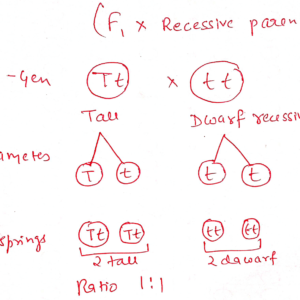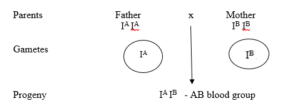Class 12 Biology CH 5 Principle Of Inheritnce And varation.
1.Mention the advantages of selecting pea plant for experiment by Mendel.
Sol-
- Easily Available in large scale.
- Many varieties present with distinct characters.
- They are bisexual plants.
- They have short life span.
- seven pairs of contrasting characters are easily detectable.
2. Differentiate between the following –
(a) Dominance and Recessive.
| Dominance | Recessive |
| When an allele express itself in the presence or absence of its recessive factor is called dominance | The recessive allele will not express its effect over dominant allele |
| The dominant allele is represented in capital letters | The recessive allele is represented in small letters. |
(b) Differences between homozygous and heterozygous individuals :
| heterozygous | homozygous |
| It contains Both dominant and recessive alleles for traits. | It contains either dominant or recessive type alleles |
| Two types of gametes are produced | Only one type of gamete is produced. |
| They show complete dominance, codominance or incomplete dominance | It can be either homozygous dominant or homozygous recessive. |
| It contains two different copies of alleles coding for a particular trait. | It has two same copies of the same allele coding for a particular trait. |
(c)Monohybrid and Dihybrid:
| Monohybrid | Dihybrid |
| It involves a cross between individuals differing
in only one pair of characters. |
It is a cross between individuals
differing in two pairs of contrasting characters. |
| The cross between tall (TT)
and dwarf (tt) pea plants is monohybrid. |
The cross between plants having
yellow round (YYRR) seeds with those having green wrinkled (yyrr) seeds is dihybrid |
3.A diploid organism is heterozygous for 4 loci, how many types of gametes can be produced?
Sol- It refers to the place of the chromosome where genes are positioned. So, we can say that loci and genes are synonyms of each other. If a diploid organism is heterozygous for 4 loci then it will have four contrasting traits Aa, Bb, Cc, Dd and during meiosis 16 different kinds of gametes will be formed.
4. Explain the Law of Dominance using a monohybrid cross.
Sol- The Law of dominance states that when a pair of alleles or allelomorphs are brought together in F1 hybrid, then only one of them expresses itself, masking the expression of the other completely. Monohybrid cross was made to study the simultaneous inheritance of a single pair of Mendelian factors. The cross in which only alternate forms of a single character are taken into consideration is called a monohybrid cross. The trait which appeared in the F1 generation was called dominant and the other which did not appear in the F1 population was called recessive.
5. Define and design a test-cross.
Sol- When an individual is crossed with the homozygous recessive parent. It is called test cross.
It helps in establishing hetero/ homozygosity of dominant trait.

6. Using a Punnett Square, workout the distribution of phenotypic features in the first filial generation after a cross between a homozygous female and a heterozygous male for a single locus.
Ans- Refer ncert book
7. When a cross is made between tall plant with yellow seeds (TtYy) and tall plant with green seed (Ttyy), what proportions of phenotype in the offspring could be expected to be
(a)tali and green.
(b)dwarf and green.
Ans- refer NCERT
8. Two heterozygous parents are crossed. If the two loci are linked what would be the distribution of phenotypic features in F1 generation for a dihybrid cross?
Ans- The process of co-existence of two or more genes in the same chromosome is termed as linkage. If the genes are located close to each other and on the same chromosome, they are inherited together and are referred to as linked genes. If two heterozygous parents exhibit linkage, then the outcome is as follows:
Parents BbLl x BbLl
Genotype Blue long Blue long
Phenotype in F1 in all the possible may exhibit parental characters as the genes are linked completely. With all the possible genotypes in F1 progeny can display blue long type of phenotype in the above-mentioned example. However, if there is an incomplete linkage, the parental combination will comparatively be more than the newer combinations which are less in number.
9. Briefly mention the contribution of T.H. Morgan in genetics.
Ans –
- He observed and worked on mutation.
- He gave the technique for chromosome mapping.
- He contributed to the understandings of sex linked traits.
- He stated the chromosomal theory of linkage.
- He proposed the theory of inheritance.
10. What is pedigree analysis? Suggest how such an analysis, can be useful.
Ans- It is the study of pedigree for the transmission of particular trait and finding the possibility of presence or absense of that trait in heterozygous or homozygous state in a particular individual.
Its useful because :
- The analysis is helpful in indicating the origination of a trait and its flow in ancestors
- It explains the reason why marriage between close relatives is harmful
- It helps in extensive research in the field of medical science.
- It can be used to trace the inheritance of a particular trait, abnormality or any disease.
- It suggests that Mendel’s principles can be applied to human genetics with some alteration such as quantitative inheritance, sex-related linkage and characters.
11. How is sex determined in human beings?
Ans- The sex of an individual in humans is determined by the genetic information present in the individual’s sex chromosomes. In humans, males have two different XY chromosomes and females have two similar chromosomes (XX).
In the process of fertilization, if the sperm containing X chromosome fertilizes the egg, then the developing offspring would be a female (XX) and if the sperm containing Y chromosome fertilizes the egg, then the developing offspring would be a male (XY). Therefore, the sex ratio that is produced in the progeny is 1:1.
12. A child has blood group O. If the father has blood group A and mother blood group B, work out the genotypes of the parents and the possible genotypes of the other offsprings.
Ans- if father has blood group A and mother has blood group B, then the possible genotype of the parents will be as follows:

13. Explain the following terms with example
(a) Co-dominance
(b) Incomplete dominance
Ans- : (a) Codominance : Codominance is the phenomenon of two contrasting alleles of the same gene lacking dominant recessive ratio and expressing themselves simultaneously when present together. E.g. ABO blood group system – Human blood group AB is formed when alleles of blood groups A and B are present together (IAIB).
(b) Incomplete dominance : Incomplete dominance may be defined as the partial /expression of both alleles in a heterozygote so that the phenotype is intermediate between those of two homozygotes. In this none of the allele is completely dominant, e.g., Pink colour flower in dog flower. In Mirabilis jalapa & Snapdragon or dog flowers
14. What is point mutation? Give one example
Ans- The process of abrupt change in the structure of gene due to change in the single-base pair of DNA is called mutation. eg- sickle cell anemia.
15. Who had proposed the chromosomal theory of the inheritance?
Ans- Theodore Boveri and Walter Sutton proposed the chromosmal theory of inheritance in 1902.
16. Mention any two autosomal genetic disorders with their symptoms.
Ans- Phenylketonuria : Retardation in physical and mental health, hypopigmentation of hair and skin.
Colour Blindness : Person cannot distinguish between red and green colour.